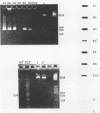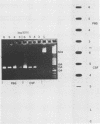Abstract
Enteroviruses are among the most common causes of childhood infection. Current diagnostic techniques are often too slow and too insensitive to benefit the patient optimally. This report describes a modified polymerase chain reaction technique by which enteroviral RNA can be amplified, over a few hours, to a level detectable by agarose mini-gel electrophoresis or nucleic acid hybridization or both. Three oligomeric regions of great homology among the enteroviruses were identified and designated as a potential primer pair and probe. With this combination, all 11 of the enterovirus serotypes tested, representing the major subgroups of these pathogens, were successfully amplified and detected. The sensitivity and rapidity of this new assay speak to its potential clinical applicability in the diagnosis of enterovirus infections.
Full text
PDF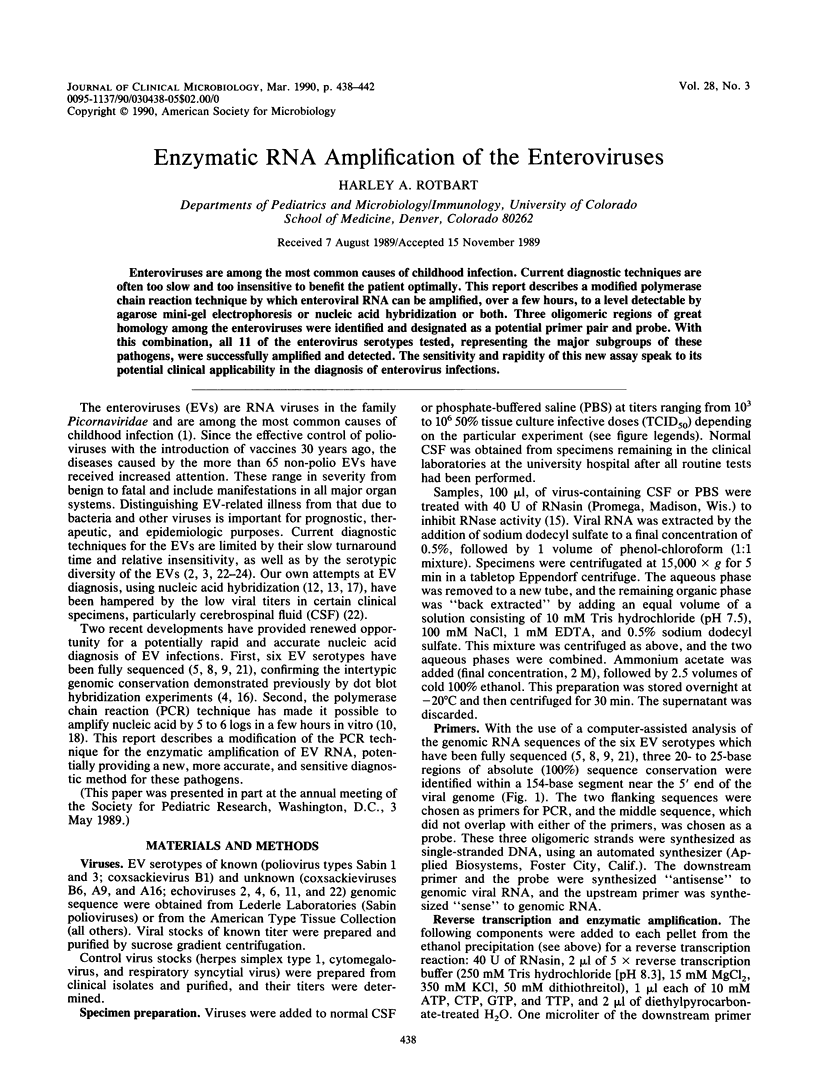
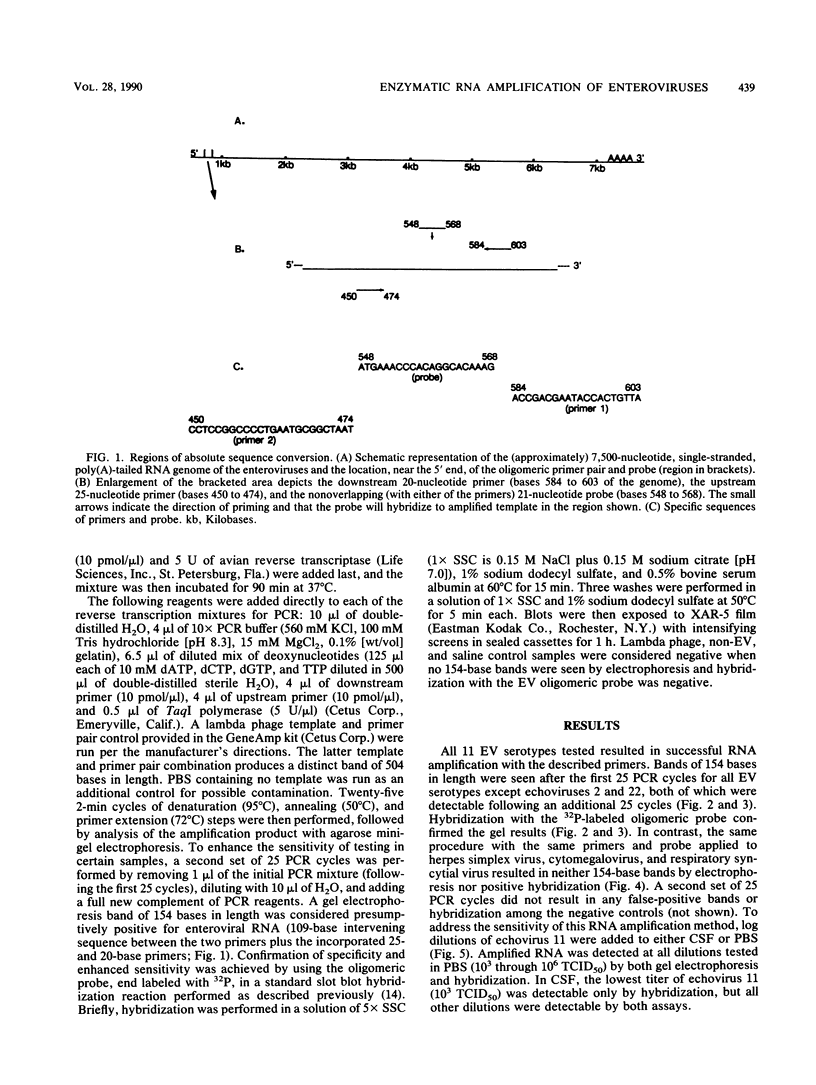
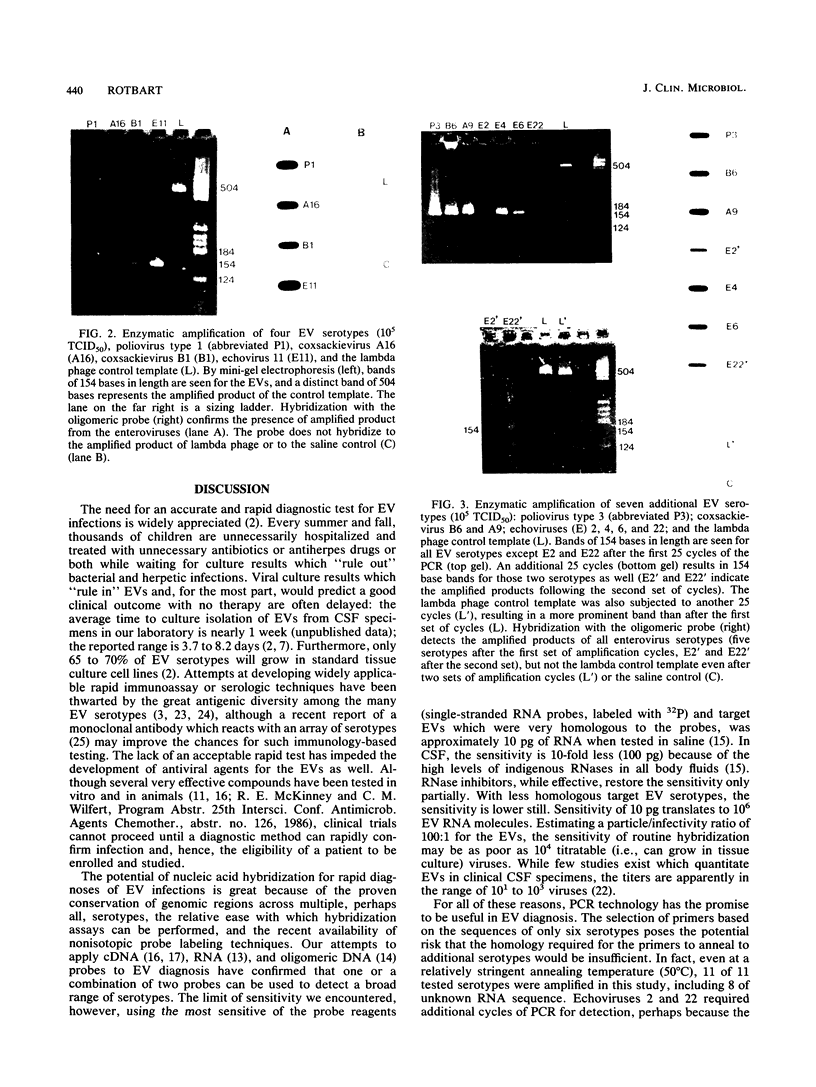
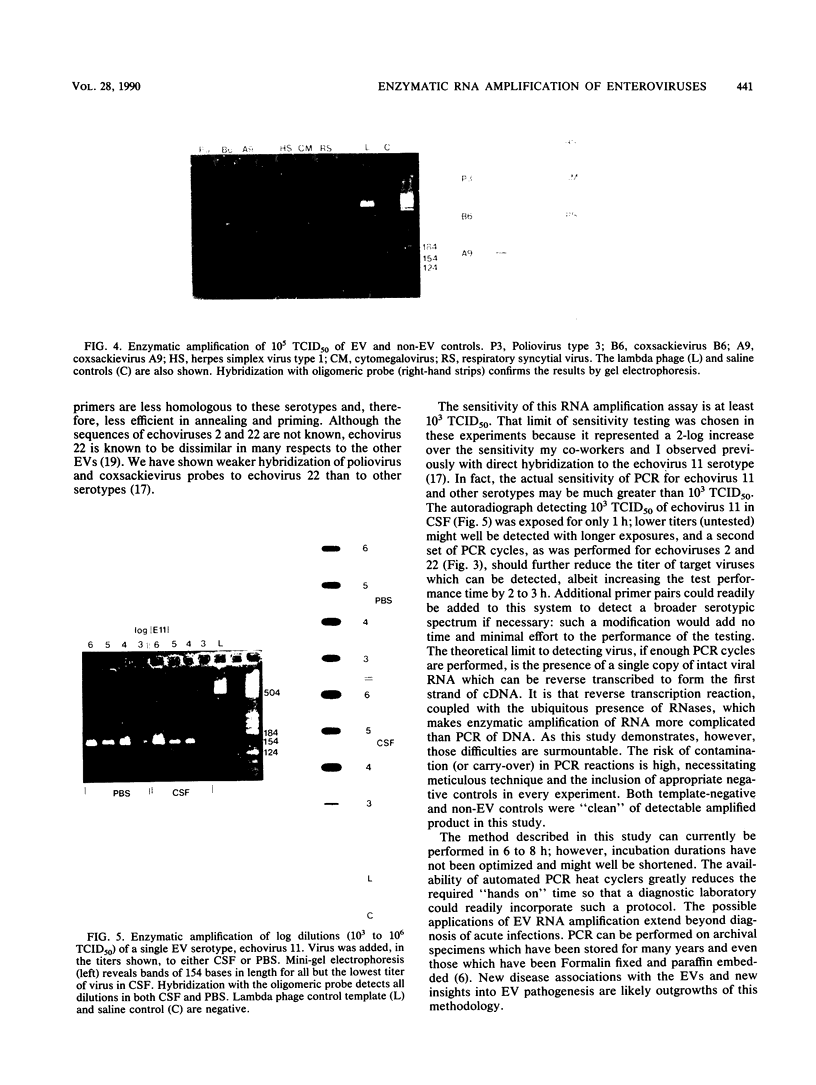
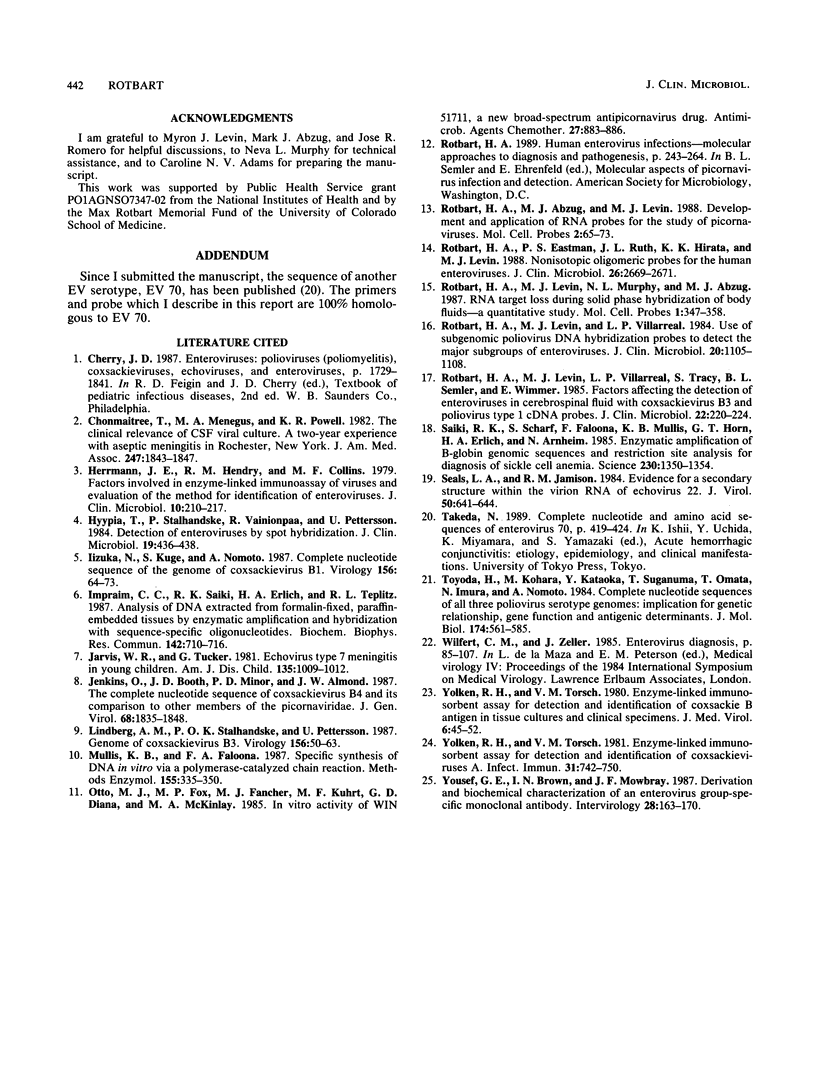
Images in this article
Selected References
These references are in PubMed. This may not be the complete list of references from this article.
- Chonmaitree T., Menegus M. A., Powell K. R. The clinical relevance of 'CSF viral culture'. A two-year experience with aseptic meningitis in Rochester, NY. JAMA. 1982 Apr 2;247(13):1843–1847. [PubMed] [Google Scholar]
- Herrmann J. E., Hendry R. M., Collins M. F. Factors involved in enzyme-linked immunoassay of viruses and evaluation of the method for identification of enteroviruses. J Clin Microbiol. 1979 Aug;10(2):210–217. doi: 10.1128/jcm.10.2.210-217.1979. [DOI] [PMC free article] [PubMed] [Google Scholar]
- Hyypiä T., Stålhandske P., Vainionpä R., Pettersson U. Detection of enteroviruses by spot hybridization. J Clin Microbiol. 1984 Mar;19(3):436–438. doi: 10.1128/jcm.19.3.436-438.1984. [DOI] [PMC free article] [PubMed] [Google Scholar]
- Iizuka N., Kuge S., Nomoto A. Complete nucleotide sequence of the genome of coxsackievirus B1. Virology. 1987 Jan;156(1):64–73. doi: 10.1016/0042-6822(87)90436-3. [DOI] [PubMed] [Google Scholar]
- Impraim C. C., Saiki R. K., Erlich H. A., Teplitz R. L. Analysis of DNA extracted from formalin-fixed, paraffin-embedded tissues by enzymatic amplification and hybridization with sequence-specific oligonucleotides. Biochem Biophys Res Commun. 1987 Feb 13;142(3):710–716. doi: 10.1016/0006-291x(87)91472-0. [DOI] [PubMed] [Google Scholar]
- Jarvis W. R., Tucker G. Echovirus type 7 meningitis in young children. Am J Dis Child. 1981 Nov;135(11):1009–1012. doi: 10.1001/archpedi.1981.02130350013006. [DOI] [PubMed] [Google Scholar]
- Jenkins O., Booth J. D., Minor P. D., Almond J. W. The complete nucleotide sequence of coxsackievirus B4 and its comparison to other members of the Picornaviridae. J Gen Virol. 1987 Jul;68(Pt 7):1835–1848. doi: 10.1099/0022-1317-68-7-1835. [DOI] [PubMed] [Google Scholar]
- Lindberg A. M., Stålhandske P. O., Pettersson U. Genome of coxsackievirus B3. Virology. 1987 Jan;156(1):50–63. doi: 10.1016/0042-6822(87)90435-1. [DOI] [PubMed] [Google Scholar]
- Mullis K. B., Faloona F. A. Specific synthesis of DNA in vitro via a polymerase-catalyzed chain reaction. Methods Enzymol. 1987;155:335–350. doi: 10.1016/0076-6879(87)55023-6. [DOI] [PubMed] [Google Scholar]
- Otto M. J., Fox M. P., Fancher M. J., Kuhrt M. F., Diana G. D., McKinlay M. A. In vitro activity of WIN 51711, a new broad-spectrum antipicornavirus drug. Antimicrob Agents Chemother. 1985 Jun;27(6):883–886. doi: 10.1128/aac.27.6.883. [DOI] [PMC free article] [PubMed] [Google Scholar]
- Rotbart H. A., Abzug M. J., Levin M. J. Development and application of RNA probes for the study of picornaviruses. Mol Cell Probes. 1988 Mar;2(1):65–73. doi: 10.1016/0890-8508(88)90045-x. [DOI] [PubMed] [Google Scholar]
- Rotbart H. A., Eastman P. S., Ruth J. L., Hirata K. K., Levin M. J. Nonisotopic oligomeric probes for the human enteroviruses. J Clin Microbiol. 1988 Dec;26(12):2669–2671. doi: 10.1128/jcm.26.12.2669-2671.1988. [DOI] [PMC free article] [PubMed] [Google Scholar]
- Rotbart H. A., Levin M. J., Murphy N. L., Abzug M. J. RNA target loss during solid phase hybridization of body fluids--a quantitative study. Mol Cell Probes. 1987 Dec;1(4):347–358. doi: 10.1016/0890-8508(87)90016-8. [DOI] [PubMed] [Google Scholar]
- Rotbart H. A., Levin M. J., Villarreal L. P., Tracy S. M., Semler B. L., Wimmer E. Factors affecting the detection of enteroviruses in cerebrospinal fluid with coxsackievirus B3 and poliovirus 1 cDNA probes. J Clin Microbiol. 1985 Aug;22(2):220–224. doi: 10.1128/jcm.22.2.220-224.1985. [DOI] [PMC free article] [PubMed] [Google Scholar]
- Rotbart H. A., Levin M. J., Villarreal L. P. Use of subgenomic poliovirus DNA hybridization probes to detect the major subgroups of enteroviruses. J Clin Microbiol. 1984 Dec;20(6):1105–1108. doi: 10.1128/jcm.20.6.1105-1108.1984. [DOI] [PMC free article] [PubMed] [Google Scholar]
- Saiki R. K., Scharf S., Faloona F., Mullis K. B., Horn G. T., Erlich H. A., Arnheim N. Enzymatic amplification of beta-globin genomic sequences and restriction site analysis for diagnosis of sickle cell anemia. Science. 1985 Dec 20;230(4732):1350–1354. doi: 10.1126/science.2999980. [DOI] [PubMed] [Google Scholar]
- Seal L. A., Jamison R. M. Evidence for secondary structure within the virion RNA of echovirus 22. J Virol. 1984 May;50(2):641–644. doi: 10.1128/jvi.50.2.641-644.1984. [DOI] [PMC free article] [PubMed] [Google Scholar]
- Toyoda H., Kohara M., Kataoka Y., Suganuma T., Omata T., Imura N., Nomoto A. Complete nucleotide sequences of all three poliovirus serotype genomes. Implication for genetic relationship, gene function and antigenic determinants. J Mol Biol. 1984 Apr 25;174(4):561–585. doi: 10.1016/0022-2836(84)90084-6. [DOI] [PubMed] [Google Scholar]
- Yolken R. H., Torsch V. M. Enzyme-linked immunosorbent assay for detection and identification of coxsackieviruses A. Infect Immun. 1981 Feb;31(2):742–750. doi: 10.1128/iai.31.2.742-750.1981. [DOI] [PMC free article] [PubMed] [Google Scholar]
- Yolken R. H., Torsch V. Enzyme-linked immunosorbent assay for the detection and identification of coxsackie B antigen in tissue cultures and clinical specimens. J Med Virol. 1980;6(1):45–52. doi: 10.1002/jmv.1890060107. [DOI] [PubMed] [Google Scholar]
- Yousef G. E., Brown I. N., Mowbray J. F. Derivation and biochemical characterization of an enterovirus group-specific monoclonal antibody. Intervirology. 1987;28(3):163–170. doi: 10.1159/000150012. [DOI] [PubMed] [Google Scholar]



